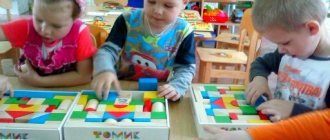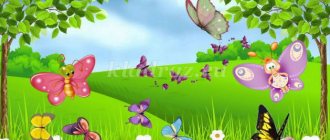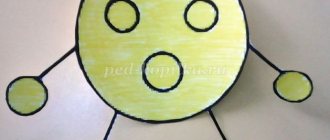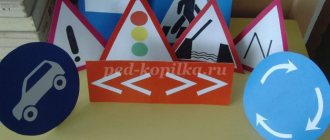“Who lives where” (mathematical game) GCD for children of the middle group
Author:
Spasennikova Irina Pavlovna,
teacher
MKDOU kindergarten "Yolochka",
Bolchary village, Kondinsky district, Khanty-Mansi Autonomous Okrug-Yugra
Goals and objectives:
FEMP: Continue teaching children to compare and correlate five objects by size.
Practice counting objects within 5. Consolidate knowledge of geometric shapes.
Develop logical thinking and spatial concepts. Enrich children's sensory experience.
FCCM: To consolidate children's understanding of wild animals and their habitat - the forest.
COMMUNICATION: Activate speech, promote the development of verbal and logical thinking, coherent speech. Learn to express in speech the relativity of sizes in width, height and justify the choice.
PHYSICAL DEVELOPMENT: Development of children’s motor activity, fine and gross motor skills; orientation in space. To promote the accumulation of tactile-motor experience in children.
SOCIAL AND PERSONAL DEVELOPMENT: To promote the development of children's cognitive and creative abilities in logical and mathematical activities. Development of intelligence, attention and ingenuity, thinking, speech.
Cultivate friendships in children and the ability to listen calmly to each other.
GCD type : FEMP with integration elements.
Materials and equipment : an envelope with a letter from the Queen of the Forest, a doll, 5 models of houses of different sizes, cards with images of animals (bear, wolf, fox, hare, mouse), cards “geometric shapes” for counting by touch, two roads (paper) identical in length but different in width, soft construction cubes, a sports beam, small wooden models of Christmas trees, cardboard white snowdrifts, a tape recorder with an audio recording of the musical game by E Zheleznova “The Giraffe Has Spots..”
Technology used: problem-based game (logical-mathematical game)
1.Organizing moment.
Exercise: “What is round? square? triangular? (ball game)
Goal: to consolidate children’s knowledge of geometric figures, to develop the ability to correlate an object with the shape of a geometric figure.
2. Plot development
Creating cognitive motivation (problem definition)
There is a knock on the door, and the children are given an envelope with a letter.
Educator: Interesting: who is the letter from? How to find out? (need to read it)
He opens the envelope and reads the letter: “Dear children of the middle group of the school “Yolochka.” Please help the fairy-tale animals: move them into houses. (models of houses are presented). Queen of the Forest."
Educator: Guys, what is the Queen of the Forest asking us to do?
How to find out how many houses were in the envelope? (Need to count)
Children count the number of houses out loud.(5)
At the bottom of the letter something else is signed: “Here are some hints for you” (shows hint cards)
Educator:
Well, let's help the fairy-tale animals? Then we need to hurry - let's read the first clue of the Queen of the Forest.
Game motivation (solving a problem through logical-mathematical activities)
Hint #1: You will find out the number of animals by touching the buttons of the geometric figure that the Christmas tree resembles.
Exercise “Find the right figure”
Material: cards - geometric shapes of different shapes (square, round, rectangular, triangular)
Goal: to train children in the ability to highlight the similarity of a geometric figure with a given object; development of figurative ideas in children.
Through reasoning, children choose a card with a triangular shape.
Physical exercise “Girls and boys, where are your fingers?”
Goal: development of fine motor skills (prepare to count objects by touch); create a positive emotional mood in children.
Exercise: “Counting objects by touch”
Material: cards - geometric shapes with buttons sewn on them.
Goal: to train children in counting objects by touch within 5; accumulation of tactile-motor experience necessary for mastering counting.
As a result of counting, children determine the number of objects: 5.
Educator: So, how long will it take us to house the animals? (5)
How many houses do we have? (5). What can you say about the number of houses and animals (they are equal, the same number)
Hint #2: You will find animals in the fairytale forest if you follow the widest road.
Exercise: “Choosing the Broad Road”
Material: two roads (paper) are the same in length, but different in width.
Goal: to train children to compare objects by width, using familiar comparison methods; develop logical thinking.
Children choose the widest road by placing or attaching objects.
Having chosen the right path, the children and their teacher hit the road.
Exercise “The Road to the Fairytale Forest” (use of sports equipment)
Material: They encounter obstacles - “snowdrifts” (soft construction cubes), “fallen trees” (sports log).
Goal: to promote children's experience of movements in space and the development of motor activity.
Educator: Well, here is the fairy forest.
Hint No. 3 Find and name fairy-tale animals.
Exercise “Who hid where?”
Material: Small wooden models of Christmas trees, cardboard white snowdrifts, cards with images of 5 animals (bear, fox, wolf, hare, mouse)
Goal: to clarify children’s knowledge about forest animals, to practice identifying the essential properties of objects (animals), and counting objects; develop spatial concepts, visual perception; activate children's speech.
Through careful examination, children determine the location of each animal, briefly characterizing it.
Educator: Have you found all the animals? How to find out?
By counting, the number of fairy-tale animals is determined.
Educator: Oh, the bunny wants to play with us. Do you agree?
Exercise “Eyes, eyes, where have you been?”
Purpose: to help strengthen the eye muscles.
Hint #4: You will find a place for houses and animals if you go to the right.
Through reasoning and orientation in space, children, with the help of a teacher, determine the right and left sides. And they choose which direction to go next: to the right.
Educator: So we got to the right place.
Children sit on chairs in front of a magnetic board
Hint #5: It turns out that animals have cards. The cards say what size house each animal wants to live in.
Exercise: “Place the animals in houses”
Materials: 5 house layouts of different sizes, 5 cards with images of animals.
Purpose: to train children in comparison and practical correlation of objects by size; teach children to justify their choice in speech.
Children themselves choose which animal to house first, which second, etc. The teacher reads the animal cards, the children choose a house for this animal.
The bear wants to live in the biggest house.
The fox will settle in the house that is second in order, if you count from left to right.
The wolf will settle in a house that is slightly lower than the second one.
The hare will settle in the house that is second from the right.
The mouse wants to live in the smallest of all houses.
While looking at animals, children name the sizes of houses; explain why the animal is placed in this particular house (they take into account the size of the house and the animal, its requirements)
3.Result.
Educator: Does each animal have its own house? This means that we have completed the task of the Queen of the Forest. And here is the Queen of the Forest herself. (The Queen of the Forest doll is brought in)
Queen of the Forest: Thank you for helping the fabulous animals. You are kind, attentive, smart and friendly guys.
Educator: Dear Queen of the Forest! Our girls and boys not only know a lot about animals and help them, but they also know a lot of games about a wide variety of animals. Here is one of them.
Musical game “The giraffe has spots, spots”
Queen of the Forest: Well done! Remain always so cheerful and cheerful! And take care of nature! In memory of our meeting, I give you these coloring books (the teacher hands out coloring books to the children). Goodbye, see you again in the fairy forest! ("leaves")
The children say goodbye to the Queen of the Forest.
Educator: Let's say goodbye to fairy-tale animals. And let's return to our group.
They are heading back.
4. Reflection.
Educator: So we returned to the group. Where were we today? Whoever liked to help the animals of the fairytale forest today, let him take a cheerful, joyful Christmas tree; and whoever found it uninteresting and difficult today, let him take the sad Christmas tree.
Next comes the exchange of impressions.
Sources:
1.Z. A. Mikhailova and others. Theories and technologies of mathematical development of preschool children. - St. Petersburg: “Childhood-Press”, 2008.
2. Pomoraeva I.A. , Pozina V. A. Classes on the formation of elementary mathematical concepts in the middle group of kindergarten. Lesson plans. - 2nd ed., revised. and additional - M.: MOSAIKA-SYNTHESIS, 2010.
3. Audio recording of the musical game by E. Zheleznova “The giraffe has spots..”
“Certificate of publication in the media” Series A No. 0002171 date of sending the registered parcel September 6, 2013. Receipt No. (mail ID) 62502663120229
We invite teachers of preschool education in the Tyumen region, Yamal-Nenets Autonomous Okrug and Khanty-Mansi Autonomous Okrug-Yugra to publish their teaching materials: - Pedagogical experience, original programs, teaching aids, presentations for classes, electronic games; — Personally developed notes and scenarios of educational activities, projects, master classes (including videos), forms of work with families and teachers.
Why is it profitable to publish with us?
1. “Kindergartens of the Tyumen Region” is an officially registered specialized media outlet at the federal level. 2. The activities of the editorial office are supported by the Department of Education and Science of the Tyumen Region 3. We issue a “Certificate of Publication” in the media. 4. The document has a unique number, is entered in the register, has the original seal of the editorial office of the online publication and signature. 5. “Certificate of publication” in the media is sent to the author in both paper and electronic versions.
Details >>>
Sample “Certificate of publication of author’s methodological material in the media.”pdf
Share






